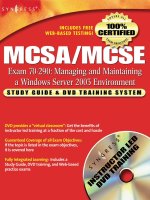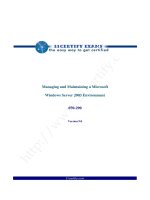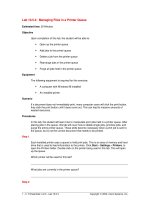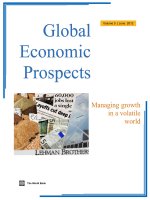Managing workplace diversity a contemporary context
Bạn đang xem bản rút gọn của tài liệu. Xem và tải ngay bản đầy đủ của tài liệu tại đây (4.81 MB, 241 trang )
ManagingWorkplaceDiversity
AContemporaryContext
NirmalKumarBetchoo
Downloadfreebooksat
Nirmal Kumar Betchoo
Managing Workplace Diversity
A Contemporary Context
2
Download free eBooks at bookboon.com
Managing Workplace Diversity: A Contemporary Context
1st edition
© 2015 Nirmal Kumar Betchoo & bookboon.com
ISBN 978-87-403-1031-3
Peer reviewed by Mr Krishnah Moortee Saurty, Senior Lecturer,
Universite des Mascareignes.
3
Download free eBooks at bookboon.com
Managing Workplace Diversity:
A Contemporary Context
Contents
Contents
Preface
6
1
Introduction to Management of Workplace Diversity
8
2
Gender Issues in Workplace Diversity
21
3
Age Issue in Workplace Diversity
35
4
Generation Issue in Workplace Diversity
47
5
Social Class in Workplace Diversity
61
6
he Impact of Culture on Workplace Diversity
74
7
he Foreign Worker in Workplace Diversity
87
8
Race Issues in Workplace Diversity
102
www.sylvania.com
We do not reinvent
the wheel we reinvent
light.
Fascinating lighting offers an ininite spectrum of
possibilities: Innovative technologies and new
markets provide both opportunities and challenges.
An environment in which your expertise is in high
demand. Enjoy the supportive working atmosphere
within our global group and beneit from international
career paths. Implement sustainable ideas in close
cooperation with other specialists and contribute to
inluencing our future. Come and join us in reinventing
light every day.
Light is OSRAM
4
Download free eBooks at bookboon.com
Click on the ad to read more
Managing Workplace Diversity:
A Contemporary Context
Contents
9
he Disabled Worker in Workplace Diversity
116
10
he Part-Timer in Workplace Diversity
130
11
Management and Leadership in Workplace Diversity
144
12
Human Resource Management in Workplace Diversity
157
13
LGBT Issues in Workplace Diversity
171
14
HIV/AIDS Workers in Workplace Diversity
182
15
New Paradigms in Workplace Diversity
196
16
Statistical Interpretation in Workplace Diversity
211
17
Objective Questions
225
18
Essay-Type Questions
235
360°
thinking
.
Discover the truth at www.deloitte.ca/careers
5
Download free eBooks at bookboon.com
© Deloitte & Touche LLP and affiliated entities.
Click on the ad to read more
Managing Workplace Diversity:
A Contemporary Context
Preface
Preface
his book titled “Managing Workplace Diversity: A Contemporary context” is based on today’s workplace
context regarding diversity focusing on the global environment. It is a known fact that diversity is gaining
more importance nowadays than ever before given that the world better accommodates people with
diferences since it has been transformed into a global village, a term that looked distant in the past but
looks more apparent today than ever before. his calls for the acceptance of diferences which are, in
essence, the elements of diversity. Traditionally, diversity could mainly focus on gender, age and ethnicity
issues but there are new concepts like HIV/AIDS workers, dual-career couples, mobile workers, etc. that
have become part of the workplace and have their role to play in society.
he existing and new diversity paradigms has called the author to consider writing on diversity using
a concise approach but which truly represents the context. he work has stemmed from the author’s
teaching of “Management of Diversity” to students over the past ten years with the inception that texts
on diversity are quite rare or simply inadequate both in terms of content and ease of understanding.
Either issues of diversity form part of broad-based management texts or they are high-level peer-reviewed
articles which are research-based duly supported by facts and igures. Little has been seen of texts on
diversity that are easy to assimilate, simple to understand with facts on today’s context. his textbook
humbly contributes to understanding diversity based from a management perspective with an inclusion
of management and human resource management as elements worth noting in the efective approach
to diversity.
Information has been developed both from journals and textbooks with special reference to internetbased documentation namely from blogs that are written by professionals and whose contributions are
widely acknowledged and referenced throughout the texts. here is a special chapter that addresses new
paradigms in workplace diversity that are likely to impact on today’s workplace.
To create a good learning experience, case studies have been included in each chapter. hey either support
the existing literature or simply add on new information through real-life examples in the text. hey also
highlight how case studies can relate to what is being taught and learnt. here are practice questions that
help the student and reader focus on the key issues discussed per chapter covered.
A special section has been allocated to the use and interpretation of statistics relating to diversity. In order
to support literature, numerical data is important and this is where statistical data sometime help in better
gauging a theory and interpreting the information provided in a particular context. he contexts chosen
vary since they cover both advanced nations and emerging economies with recently-gained information.
6
Download free eBooks at bookboon.com
Managing Workplace Diversity:
A Contemporary Context
Preface
Objective tests that cover the diferent chapters along with a range of essay-type questions conclude
this book with particular reference made to the aspects discussed in this book. By doing the diferent
exercises, the student is expected to master the diferent concepts of diversity and have a clearer idea
of it. his is what this book intends to achieve while, once again, assuming that it remains to the point,
neither too brief and nor too elaborate. he aim was to present diversity in management in an easy-toread and understand approach.
7
Download free eBooks at bookboon.com
Managing Workplace Diversity:
A Contemporary Context
Introduction to Management of Workplace Diversity
1 Introduction to Management of
Workplace Diversity
Introduction
Diversity management is an important concept that is universally applied to the workplace. Earlier,
countries could claim to be ethno-centric in their approach by having a homogeneous race at work with
the style of sameness. If you just watch a typical American soap, it speaks of burgers, college lifestyle,
American stereotype of hero, etc. his means that stereotypes tend to give an image of what one society
is and how it might difer from others or the s-called rest of the world. his image is no truer today
especially when one speaks of a globalised world-a concept developed since the 1990s and so-widely
accepted today in all communities of the world.
Marshall McLuhan spoke in the 1960s of a global village with increased speed of communication and
the ability of people to read about, spread, and react to global news quickly (Mc Luhan, 1964), while
management writers like Ohmae (1999) commented on the borderless world with excellent opportunities
to trade without fear. hese ideas better illustrate today’s workplace with its high level of diversity. It
includes irstly people of all races combining their efort to reach the corporate goals of the irm. People
can then be of diferent gender; male and female, where they contribute more than ever before to their
organisation with and without role diferences. Next comes the age factor. A company is also like a
family with people of diferent ages. hey work together and collaborate to the wellbeing of their irm.
In diversity management, one can also come across physically handicapped or disabled workers. Although
they face a lot of discrimination due to their physical problem, they have nowadays more rights and
opportunities to work. Engaging them in the work community proves to be beneicial both to them and
the business. One can also speak of social class diferences that are broadly overcome but can vary in
terms of importance among diferent cultures. he movements in class might also explain how diversity
can address organisational issues.
hen comes the foreign employee. here are two trends that are identiiable. Firstly, people from the
developing world moved in large numbers to rich countries that were their former colonists. Secondly,
top executives are moving to developing nations to sell their managerial expertise. Foreign employees
might also invoke the issue of cultural diversity and tolerance.
here are part-timers to consider in diversity management. When economies are in dire diiculties,
new forms of employment do arise and part-timers have a key role to play in it. heir expertise and
contribution plays a key role in addressing the work problem through their diversity.
8
Download free eBooks at bookboon.com
Managing Workplace Diversity:
A Contemporary Context
Introduction to Management of Workplace Diversity
his book also covers the aspect of Lesbian, Gay, Bisexual and Transexual workers (LGBT) as an inherent
part of diversity. Being in the irm while facing the risk of stigmatisation, LGBT should have their role
to play within the business. hey are crucial to the irm’s success. Acceptance of diversity also covers the
issue of race relations which are easy tough to manage despite struggles won in many parts of the world.
here are also wider issues of diversity discussed in this book and they have been addressed within
today’s evolving environment of workplace diversity.
he Concept of Workplace Diversity
Diversity is generally deined as acknowledging, understanding, accepting, valuing, and celebrating
diferences among people with respect to age, class, ethnicity, gender, physical and mental ability, race,
sexual orientation, spiritual practice, and public assistance status (Esty, et al., 1995).
Managing diversity means acknowledging people’s diferences and recognising these diferences
as valuable. It enhances good management practices by preventing discrimination and promoting
inclusiveness. Good management alone will not necessarily help an individual work efectively with a
diverse workforce. While the traditional notion of workplace diversity may refer to representations of
various races, genders and religious backgrounds, today’s concept of workplace diversity is broad-based.
Besides these classical variables, considerations are also made on personality, age, style, skills, education,
background, etc. he focus of workplace diversity now lies on the promotion of individuality within an
organisation, acknowledging that every person can bring something diferent to the business.
An organisation that is committed to a diverse workforce is one that aims to harness a pool of individuals
with unique qualities, seeing this combination of diferences as a potential for growth rather than
opportunities for conlict. Attached to this commitment is also an intention to nurture and develop the
potential of each individual.
Organisations must understand that managing diversity is much more than gaining knowledge on race
and gender issues. Managing diversity should be viewed as providing a perspective that can enhance
creativity and growth. he discipline provides a way of thinking that allows us to view our organisational
activities through a more objective eye.
he need for businesses to embrace diversity
Diversity means empowering people. It makes an organisation efective by capitalising on all the strengths
of each employee. Diversity is also understanding, valuing, and using the diferences in every person.
Simply enforcing government regulations is not the best way to embrace diversity. To obtain that
competitive edge companies need to create great work teams by using the full potential of every individual.
9
Download free eBooks at bookboon.com
Managing Workplace Diversity:
A Contemporary Context
Introduction to Management of Workplace Diversity
Embracing diversity is the irst item for building teams. Every team building theory states that to build
a great team, there must be a diverse group of people on the team. Choosing people like oneself to be
on teams is similar to inbreeding – it multiplies the laws. While on the other end of the continuum is
having an assorted group of individuals which diminishes the laws of others.
Internally, organisations promote diversity and manage increasingly heterogeneous workforces,
accommodate and integrate employees with diferent value and belief systems and combat a range of
diferent forms of discrimination with both organisational and societal consequences (Groschl, 2011).
Externally, organisations have to manage demands from governmental, consumer and lobbying sources for
the implementation of anti-discrimination policies and laws, and for attracting and integrating employees
from minority or historically disadvantaged groups (Groschl, 2011). hese demands and activities afect
the review and revision of organisational culture, HR policies and practices and ethical standards.
Diversity: A fad or a reality today?
Is managing diversity another fad such as teamwork, downsizing, or re-engineering? Ideally, organisations
are interested in Diversity because it represents a new problem for them to deal with? One thing is
certain: diversity, especially workforce diversity is an issue most organisations have already or will need
to address in the very near future.
here are some reasons to explain why irms are interested in managing diversity.
Firstly, the workforce in many nations is becoming more diverse. Kerby and Burns (2012) state that our
nation and our workforce are both becoming more diverse. he share of people of colour in the United
States is increasing; more women are entering the labour force; and gay and transgender individuals
are making vital contributions to our economy, while being increasingly open about who they are. To
that end, businesses that embrace diversity have a more solid footing in the marketplace than others.
Secondly, the fertility rate in the traditional industrial powers is not great enough to replace their existing
populations. his means that immigration is going to be a factor in those societies and a key issue that
organisations within those societies will need to deal with.
hirdly, organisations are also beginning to emphasise the importance of cross-functional teams. his is
important because diferent work functions and diferent departments can have diferent cultures. Hence,
the ability to adapt to diferent cultures has an advantage for organisational activities.
10
Download free eBooks at bookboon.com









